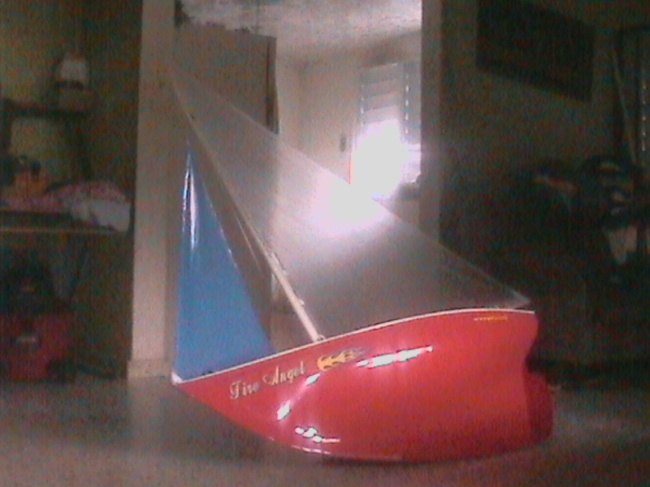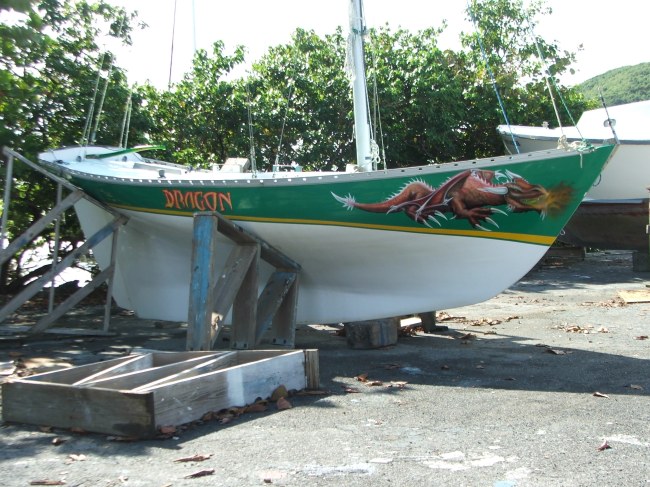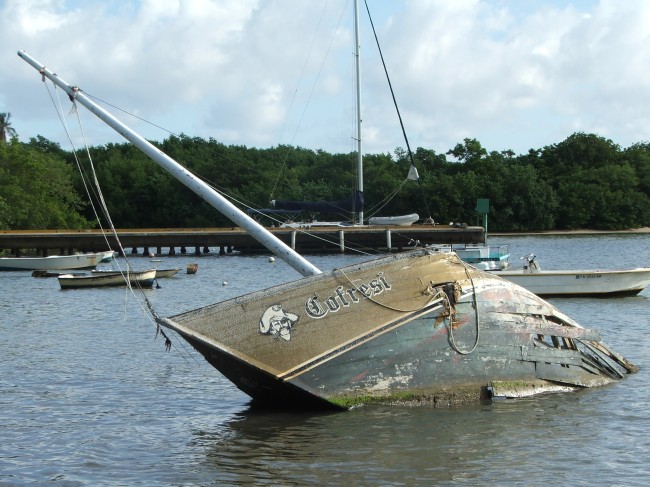You are currently browsing the tag archive for the ‘Racing boats’ tag.
Puerto Rico, like the many other Caribbean islands, as well as pretty much every populated seafaring coastal region around the world has its own style of small working sailboat. The exact design of each will be a result of historical circumstance, local requirements, locally available materials, and local hydro-graphic and meteorological conditions.
In the Caribbean islands the default style is the small sloop. Fast and handy, low cost. Each region has its own distinctive style. On my Puertorican sloop I often get confused for the better known Bahamian sloop*. However, the boats from each region all have their own unique and distinctive characteristics.
Puerto Rico is actually big enough an island to have a couple of different styles. I will focus now only on the East end of the island. Here the boats are beamy, have low freeboard ( even by traditional boat standards ) for low windage and top hamper to increase speed to windward. The mast is strongly raked, so a halyard will drop any cargo naturally straight into the hold. The locals maintain that the rake transforms the mast’s pumping into forward thrusts on the mast step. It sounds like a nice theory, but I cannot see any possible reason for this being true on the basis Newtonian laws, however. Another reason which is very important, is that the rake of the mast obliges the long and low boom to swing upwards when the sheet is eased, keeping it from hitting the water too much.
They never have reef points, instead just letting the mainsheet out feathering the mainsail, exactly as is done on most racing dinghies. For this reason it is a mistake to put belly in the main, which should be cut traditionally, as flat as possible. Running backstays secure the mast when running. Upwind, they are optional, since the mainsheet tension on that lever arm is enough to keep the forestay taut enough. In addition the rake makes the weight of the rig pull back on the forestay. Originally it was the norm to set up a short gunter sprit, set up on one halyard, in order to have something to lace the luff to , above the hounds. This had the further advantage of assuring smart sail lowering (due to its weight) , as well as extending the sail up above a shorter mast.
The keel is markedly raked, the bilges very high and slack with lots of flare. The bows are high and fine to deal with the chop on the windward end of the island, stem usually straight at between 20 and 40 degrees to the vertical. The sternpost is at about 30 degrees with transom hung rudder.
When I was around thirteen years old, I had a chat with Don Gelo, undoubtedly the island’s best shipwright, as I would fairly regularly – undoubtedly disrupting his work – but he would always take the time to answer my many questions and discuss other boat matters with me. That particular time though, was about the Nativos and he explained the rules of proportion like so; The beam is one third of the length, or a little less, the mast measures overall length + beam + draft. It is stepped at one third of the length and at right angles to the deck. The boom should be a little longer than the boat. All the ballast must be placed in the middle third of the boat. **
They are always three quarter decked. They never have engines as it would ruin the sailing performance. The only exception I have seen is on the Angel Negro which is employed to take tourists out to Icacos island. Here the 90 year old owner put on an eight (I think) horsepower outboard on a bracket to save himself the effort of tacking out of the narrow entrance of Las Croabas harbour.
The ballast is always internal, apart from the mini Nativos which on account of scaling laws*** need to put at least half their lead in the keel (thus lowering the centre of mass, in addition the mini Nativos have proportionately greater draft.)
Lead pigs is the preferred option, but often a combination of lead and iron pigs will be used in the interests of economy, the lead always under the iron, both to be more effective but also to deter the theft of the valuable lead, something which happens frequently. Originally, in the old working boat days, pig iron, steel scrap, beach stone, sand bags and even blocks of cement were standard ballast options to keep costs down. Nowadays, the boats still carry a substantial amount of ballast as wet sand in 40 kg bags so as to move ballast on the windward deck. The mini Nativos don’t bother shifting any ballast, instead putting crew on the trapeze. They will, however dump out any no longer needed sand ballast during a race depending on the circumstances.
Construction varies from extremely crude to well crafted, following standard wooden boat traditional rules. Frames are always double sawn grown crooks, save for the front third or so where single sawn grown lumber can be used, on account of the relatively straight line sections there. Frames are traditionally cut from local mahogany – caoba – “Swietenia mahagoni”, Majaguilla Thespesia populnea ”, or red Mangrove Rhizophora mangle. It is not uncommon to mix different species for the frames. Uva “Coccoloba uvifera”, is a favourite for the stem due to its toughness and naturally growing in curves. Capa prieto “Cordia alliodora ”, is prized for the sternpost and keel. The planking is usually store bought pre-milled pine boards, imported from USA, to save on labour, and also because Puerto Rico no longer has much local lumber. Since the keel is strongly raked, putting in stealers is standard practice.
Lately though, less experienced shipwrights have been building boats with poorly fitted construction grade plywood planks, the whole then liberally slathered in ‘Bondo’ to try to correct the unfairness and heavily fiberglassed with polyester resin. These boats are of rather questionable quality to say the least. But at least they provide much fun for racing during their usually rather short life anyways.
Originally these boats would be used for fishing, mostly traps. Here the low freeboard is a further advantage in order to get the traps on-board. The large keel area makes the boat drift extremely slowly despite not having any way on. They would sail up to one of their buoys, drop the jib and let out the main sheet. The mainsail being very low aspect ratio means it flogs but very gently and the boat remains at a standstill at a fixed angle to the wind, this angle depending on the amount by which the main sheet is slacked, the mainsail acting as a huge weathercock.
Then to sail over to the next trap, it is just a matter of hoisting the jib and sheeting in the main.
As mechanically propelled boats became more and more the norm for fishing work, the sailing fishing boats, along with the other sailing work-boats got displaced. The last sailing fishing boat I saw was a 26 footer (7.9 M) on the west coast, but this one did have a very small auxiliary inboard engine of probably about two or three horsepower, to save the old man the effort of tacking into the harbour of Puerto Real. That was in about 1988. Soon after, the boat was laid up never to be sailed again.
However, the traditional east coast sail boat avoided extinction, by being re-purposed into racing boats. This was a natural transition as fishing boats are racing boats already. After all, no one wants to be the last boat back from the fishing grounds, practically having to give the fish away to the few people who somehow didn’t manage to buy the fresher earlier fish at the market.
Racing produced its own evolution; rigs became bigger, overlapping jibs were introduced, sail tracks and other modernizations adopted. The boats were being made with more draft too, the most being nine feet on a 34 footer (10.4 M). In the eighties, the mayor of the municipality of Fajardo, who was a big fan of the Nativo races, and having seen a good few dismastings donated a bunch of tapered aluminium light poles to be used as masts. All the boats converted to the stronger and lighter hollow aluminium poles, making dismastings a thing of the past. Not all the modernizations have been beneficial, however; the overlapping jib is a dubious advantage as it would be more effective to put that extra sail area out in the open, and it slows tacking down. Also the track on the mast now prevents the sail from rotating to the downstream point of the mast creating a bigger than necessary flow disturbance on the important side of the sail, the lee side.
On the Jaguar, no doubt the most well known Nativo, one can see there is little hesitance to experiment and innovate as well as spend money. The jib is an impeccably fitted mylar/kevlar laminate, for instance. Other experiments do not turn out so well; at one time they cast her an external ballast keel. The boat broke a large percentage of frames on the first trial, which forced extensive repairs and for all the lead to be removed, cut up and put back on the inside. They learnt the hard way that scantlings have to matched to the nature of the ballast.
The shift to racing was also the cause of the emergence of the mini Nativo, boats in the 4.5 to 7 meter range which are easier to justify economically and still provide plenty of thrills for participants and spectators alike. These are typically fitted with battens and often use spreaders as further modernizations atypical in the larger boats.
The races are set up by drawing numbers out of a hat to decide which boat will get which mooring buoy, the buoys having been set up earlier in a straight line at right angles to the wind. The boats take up their determined positions and get everything ready, including hoisting the mainsail. When the signal sounds, the mooring is slipped and the jib hoisted at lightning speed. This is fair for everyone and avoids the aggressive pre-start jostling for position and its attendant risk of collisions.
Usually the courses will involve sailing a circuit around various islands which make them sometimes pass extremely close to reefs. It can be quite unnerving to watch coral-heads flash by inches under the keel. Local knowledge is a must obviously! Another hazard in the races is sinking by the sheet-man being reluctant or too slow to free up in gusts on windy days. These are inevitable hazards when racing boats which are not fully decked. In this eventuality, the boat is always recuperated later by sending divers down to place the ballast, pig by pig, in buckets or bags tied to a rescue launch at the surface and hoisted aboard by the crew upon the command of a jerk on the line. If the launch is not big enough to hold all the ballast, several trips will be required, transferring the ballast to shore in stages. Once the boat is free of all ballast it floats up by itself and can be bailed out and the ballast put back into place.
Heavily ballasted open boats are by nature a risky affair, and more so when the sail area is so ample. Certain tricks are employed though to keep things under control; One is using a slip knot on the halyards and sheets, instead of just belaying onto a cleat. If the conditions get dicey the fall of the lines can be kept in a hand or close at reach. A smart jerk on the line will instantly release the desired line.
Competition is fierce with many thousands of dollars being wagered enthusiastically. Pre-race sabotage is common, and as a precaution a free diver with mask is sent down a little prior to the race to check that no buckets or other hamper have been attached to the keel. In another case some unidentified opponent stole the rudder of the Oasis the night before a big race. They discovered this soon after the fact by chance and Don Gelo spent all night making a new rudder so as to still be able to race, not a small feat on a Saturday night when the lumber yards are closed and the rudder is a mighty slab of sculpted wood 4” thick and eleven feet long.
The larger boats will race with up to 15 or 16 people on board on a windier day, a large part of that crew being employed for the task of shifting ballast as quickly as possible when tacking. It is not unheard of to put over one ton of ballast on the windward deck, which with the weight of the crew can then come up to a total of well over two tons to windward giving tremendous sail carrying power. On the last downwind leg (if there is one; they don’t always do that kind of course) all the sand is frantically emptied out of the bags overboard to lighten up the boat for that last scramble to the finish line.
Other crew will have the following specific tasks; helmsman, mainsheetman, jibsheetman, runnerman, bailer (always the lightest man) and tactician. This last is almost invariably also the captain.
However, it is sadly a dying breed. The youth are more interested in keeping up appearances by buying shiny cars and plasma TV’s on credit than the hard work of saving up to purchase or build a sailboat. The knowledge of boat building itself is disappearing. Boats are being lost faster than they are being built. Don Gelo, by far the best boat builder on Puerto Rico is getting old, and despite his son’s claims, his son is not the master craftsman his father is. Furthermore, with the economy going to the wolves, fewer and fewer people can afford to have a sailboat which is not a reliable profit earner. Not all hope is lost though, as there is still a lot of interest possibly growing even in the mini version of the Nativos, especially on the south and south east coasts, these smaller boats being more economically accessible.
* There are numerous differences between the Bahamian sloop and the Puerto-Rican sloop; The Bahamian sloops have much more upright stems, much deeper and harder bilges, less mast rake, less rake in the keel. Less draft also due to the generally shallow waters of the Bahamas. The masts are stepped considerably further forward and the main always has a large headboard – definite Block Island and Catboat influence there.
** & *** I will write a future post about this subject.











